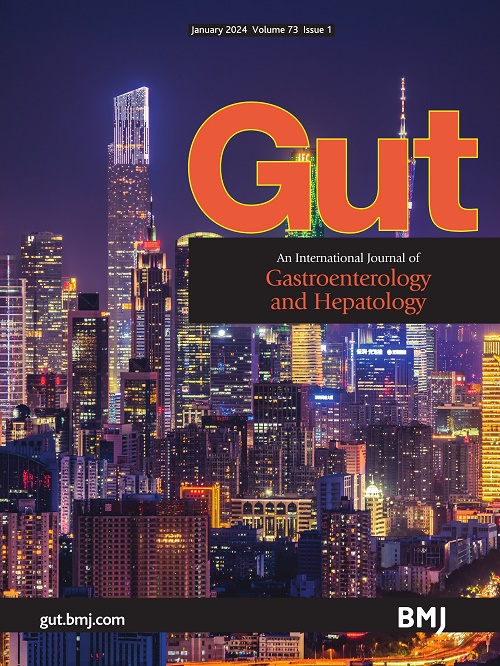To be or not to be (a biliary cancer): RAS (signalling) is the question
IF 25.8
1区 医学
Q1 GASTROENTEROLOGY & HEPATOLOGY
引用次数: 0
Abstract
Intrahepatic cholangiocarcinoma (iCCA) is the second most prevalent type of primary liver cancer, presents with a highly dismal prognosis, and its incidence is on the rise compared with most cancers.1 iCCA features histological traits of the biliary tract including expression of biliary epithelial cell markers such as SRY-box transcription factor 9 and cytokeratin 19. Based on the histological appearance, iCCA has been considered to arise from mature cholangiocytes. Indeed, epidemiological studies associate iCCA with pathological conditions involving the biliary compartment such as primary sclerosing cholangitis and liver fluke infection.1 Nonetheless, the presence of mixed hepatocellular carcinoma (HCC)/iCCA tumours, along with the association of iCCA with conditions affecting the hepatocellular compartment such as hepatitis B and C, and cirrhosis, points to the potential involvement of additional cell types, such as hepatocytes, in the origin of iCCA.1 Pioneering lineage tracing studies reported the development of murine iCCA derived from hepatocytes on treatment with the carcinogenic agent thioacetamide or by hydrodynamic tail vein injection (HTVI) delivery of iCCA-related oncogene Notch (ie, Notch intracellular domain), into hepatocytes of adult mice using the Sleeping Beauty transposon-transposase system.2 3 Hepatocyte to biliary cell (H-BC) transdifferentiation was further supported by subsequent studies using HTVI to overexpress oncogenes and/or deplete tumour suppressor genes (TSGs) and, more recently, by the use of adeno-associated virus with preferential tropism to hepatocytes.4–8 While these studies started to highlight that different liver injuries and pro-oncogenic insults foster H-BC transdifferentiation, the molecular understanding of how this process is regulated is far from being complete. This issue of Gut features a study …生存还是毁灭(胆道癌):RAS(信号)是一个问题
肝内胆管癌(iCCA)是第二常见的原发性肝癌类型,预后非常差,与大多数癌症相比,其发病率呈上升趋势。1 iCCA具有胆道的组织学特征,包括胆道上皮细胞标志物如SRY-box转录因子9和细胞角蛋白19的表达。根据组织学表现,iCCA被认为起源于成熟的胆管细胞。事实上,流行病学研究将iCCA与涉及胆道室的病理状况(如原发性硬化性胆管炎和肝吸虫感染)联系起来然而,混合肝细胞癌(HCC)/iCCA肿瘤的存在,以及iCCA与影响肝细胞室的疾病(如乙型肝炎、丙型肝炎和肝硬化)的关联,表明iCCA的起源可能涉及其他细胞类型,如肝细胞开创性的谱系追踪研究报道了小鼠iCCA的发展,这些小鼠的iCCA来源于用致癌物硫乙酰胺治疗的肝细胞,或通过尾静脉注射(HTVI)将iCCA相关的致癌基因Notch(即Notch细胞内结构域)通过睡美人转座子-转座酶系统递送到成年小鼠的肝细胞中。2 3随后的研究进一步支持了肝细胞向胆道细胞(H-BC)的转分化,这些研究使用HTVI过度表达癌基因和/或消耗肿瘤抑制基因(TSGs),以及最近使用具有肝细胞优先倾向的腺相关病毒。4-8虽然这些研究开始强调不同的肝损伤和促癌损伤可促进H-BC转分化,但对这一过程如何调节的分子理解还远未完成。本期《肠道》杂志刊登了一项研究……
本文章由计算机程序翻译,如有差异,请以英文原文为准。
求助全文
约1分钟内获得全文
求助全文
来源期刊

Gut
医学-胃肠肝病学
CiteScore
45.70
自引率
2.40%
发文量
284
审稿时长
1.5 months
期刊介绍:
Gut is a renowned international journal specializing in gastroenterology and hepatology, known for its high-quality clinical research covering the alimentary tract, liver, biliary tree, and pancreas. It offers authoritative and current coverage across all aspects of gastroenterology and hepatology, featuring articles on emerging disease mechanisms and innovative diagnostic and therapeutic approaches authored by leading experts.
As the flagship journal of BMJ's gastroenterology portfolio, Gut is accompanied by two companion journals: Frontline Gastroenterology, focusing on education and practice-oriented papers, and BMJ Open Gastroenterology for open access original research.
 求助内容:
求助内容: 应助结果提醒方式:
应助结果提醒方式:


